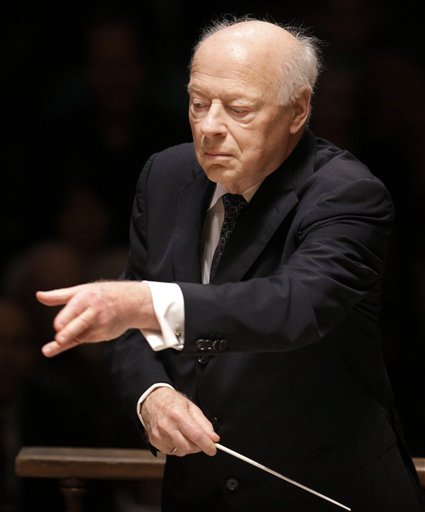Haitink, BSO more stolid than stirring in Brahms and Schumann
The Boston Symphony Orchestra will have to wait another year before appearing in New York with their new, young music director Andris Nelsons. In the meantime, they opened their 2014 Carnegie Hall stand on Tuesday under the baton of their old friend Bernard Haitink, and while they have rarely sounded more polished, youthful vigor seemed to be exactly what was missing.
They began with a head-scratcher: Funeral Music for Queen Mary, a Steven Stucky “re-composition” of three pieces by Henry Purcell. In his own notes on the piece, Stucky insists that his goal was to present Purcell’s music “through the lens of 300 intervening years,” and the result is mostly re-orchestration, with moments of harmonic adventure.
The first of the three is a somber march, set for winds and limited percussion, with an authoritative brass presence. The anthem “In the Midst of Life We Are in Death” is the most baffling of the set, sounding almost like a straight transcription of Purcell’s choral version.
Only in the canzona does Stucky embark on any real exploration, using harp and piano to alter the palette, and allowing lingering voices to turn the counterpoint inside-out. The piece has its moments of interest, but does not offer anything especially new or reveal much about Purcell’s music. What it does offer is a chance for Boston’s brass to show off, which they did, warm and confident.
Murray Perahia joined Haitink and the BSO for Schumann’s Piano Concerto, playing with polish, poise, and intelligence. Unfortunately, he was a little stodgy with the piece, giving a straightforward account, well crafted but cool.
It did not help that he was playing on a particularly dark piano. Its muted color allowed him to achieve a turbulent, rolling effect, but there was nothing to cut through the fog. When he needed to sparkle or soar, he sounded more muffled than anything else.
The second movement featured some gorgeous crooning in the cello section, and Perahia communicated with them well, but still failed to command attention. He approached the concerto like a chamber musician, not in the sense that he was closely attuned to his collaborators—although in that regard he was exemplary—but rather in that he didn’t really take charge of the interpretation. The third movement was certainly “allegro,” but had too much girth to be truly “vivace”—a solid, enjoyable performance that nonetheless felt complacent.
Complacency marred Brahms’s Fourth Symphony, as well. The BSO’s sound was refined and luxurious, but their playing was also casual, one thing Brahms’s Fourth is not.
The problem in the first movement was one of pace—a tripping initial tempo established forward energy, but the music did not unfold organically. A taut energy runs from the opening bars through to the end of the first movement, and while Haitink’s rolling pace kept it moving forward, he did not venture far out of his base tempo, and where he did he was more comfortable to rein in than let loose. Brahms’s writing in this movement wanders in many directions, but there is a continuity of thought as it keeps returning organically to the initial idea. When it is as controlled as Haitink made it, it begins to feel episodic.
The second movement was the gem of the performance—at once intimate and distant, it featured some of the most gorgeous wind playing you’ll ever hear, tender and thoughtful. The initial horn solo was almost too confident, but thereafter the piece resolved into complete stillness. For a moment, as the winds fell silent, leaving only pizzicati in the strings to finish the phrase, it approached pure bliss.
The allegro giocoso, by contrast, had the appropriate boisterousness to it, but sat a touch heavy. Much of it was barreled through in the lower strings and the brass, while the violins seemed concerned with being overly precise, bottling up their energy. As scherzos go, this is a portly one, but a scherzo it remains, and Haitink seemed to miss the joke.
There were some glorious sounds coming out of the orchestra in the finale—a steely string framework with assertive brass over it. What this performance was missing was mass. Over the course of thirty variations, Brahms’s epic passacaglia runs through a range of emotions, and Haitink’s reading was lacking on the terror-rage end of the spectrum, not employing enough bite where required, and quite simply lacking in volume. The twenty-fourth variation in particular, with its ferocious and awe-inspiring bursts of sound, didn’t fill the hall, and the string tremolo that followed was too slow to raise any hairs. As in the second movement, there were some gorgeous moments of bucolic serenity, but size matters in this movement, and it wasn’t there when it was needed.
The Boston Symphony Orchestra will perform an all-Ravel program Wednesday: Alborado del gracioso, Shéhérazade with Susan Graham, and Daphnis et Chloé with the Tanglewood Festival Chorus. carnegiehall.org
